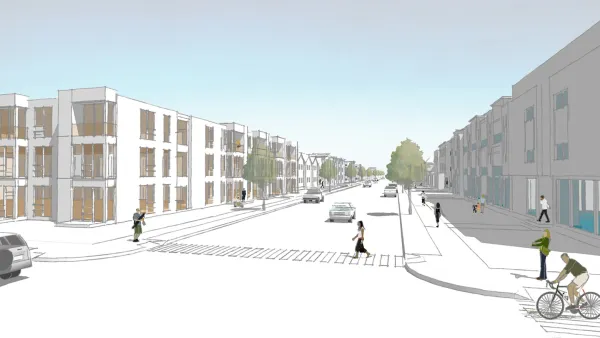Inclusionary zoning and weakened urban growth boundaries are not effective tools for reducing the price of housing. Joe Cortright of City Observatory suggests ending parking requirements instead.
Joe Cortright analyzes the potential consequences of a political trade off regarding a process to reform some of the regulations that impact land use and development in Oregon.
As has already been reported, the Oregon State Legislature is considering a package of bills that could overturn the state's ban on inclusionary zoning. The legislation is proposed as a measure to counter the state's rising affordability problem. In the negotations leading up the inclusionary zoning legislation, the development and building industries is asking for something in return:
As a quid pro quo for agreeing to drop the ban—at least for rental housing—the development industry is suggesting it would like to see the state’s land use laws, including its signature urban growth boundary, weakened.
Cortright's focuses on the consequences of "bursting" Portland's urban growth boundary. In fact, Cortright says that possibility, combined with new inclusionary zoning, would likely make Portland's affordability worse.
To back up his larger claim, Cortright lays out a seven-point argument, each detailed in the article. Here's an abridged version of the list:
- Affordability is about growing up, not out.
- The market demand/affordability problem is in the urban core.
- Adding more supply in the core is the key to addressing affordability.
- Inclusionary zoning increases market prices.
- Inclusionary zoning creates only token numbers of affordable units.
- Inclusionary zoning requirements would encourage further sprawl.
- If we want to make housing more affordable, let’s get rid of parking requirements.
FULL STORY: Bursting Portland’s urban growth boundary won’t make housing more affordable

National Parks Layoffs Will Cause Communities to Lose Billions
Thousands of essential park workers were laid off this week, just before the busy spring break season.

Retro-silient?: America’s First “Eco-burb,” The Woodlands Turns 50
A master-planned community north of Houston offers lessons on green infrastructure and resilient design, but falls short of its founder’s lofty affordability and walkability goals.

Delivering for America Plan Will Downgrade Mail Service in at Least 49.5 Percent of Zip Codes
Republican and Democrat lawmakers criticize the plan for its disproportionate negative impact on rural communities.

Test News Post 1
This is a summary

Test News Headline 46
Test for the image on the front page.

Balancing Bombs and Butterflies: How the National Guard Protects a Rare Species
The National Guard at Fort Indiantown Gap uses GIS technology and land management strategies to balance military training with conservation efforts, ensuring the survival of the rare eastern regal fritillary butterfly.
Urban Design for Planners 1: Software Tools
This six-course series explores essential urban design concepts using open source software and equips planners with the tools they need to participate fully in the urban design process.
Planning for Universal Design
Learn the tools for implementing Universal Design in planning regulations.
EMC Planning Group, Inc.
Planetizen
Planetizen
Mpact (formerly Rail~Volution)
Great Falls Development Authority, Inc.
HUDs Office of Policy Development and Research
NYU Wagner Graduate School of Public Service





























